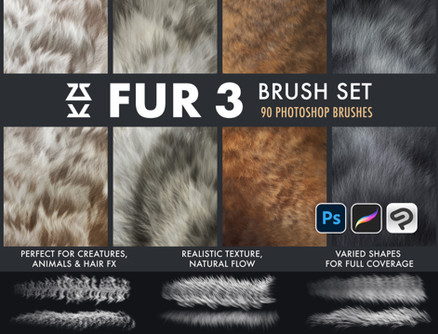HOME | DD
 Tes92 — Tutorial 2.2: necks (fur)
by-nc-nd
Tes92 — Tutorial 2.2: necks (fur)
by-nc-nd

Published: 2021-03-10 23:10:10 +0000 UTC; Views: 1435; Favourites: 56; Downloads: 0
Redirect to original
Description
We remain in the line of accessories for our dragon necks. Entering the winter collection (late XD): fur! Soft, cuddly, warm... very huggable until you realize that the owner is a huge beast full of teeth, claws, and you know how many more things that can kill you






And where can the hair go on the neck of a giant lizard? Where you want. In the drawing I put several typical examples. Let's take a look at them:
- Horsehair type: located along the upper area, covering the nape. The extension can vary to the consumer's taste, as can the length of the hair. What is important to emphasize: make sure that the hair "comes" from the neck. Let me explain: if you just start drawing the strands on the skin line, it will seem that it is simply glued, it will not be organic. It is better if you draw some strands as it appears in the drawing. In the case of being something more "mohauk" type, where the fringe of hair is thinner and the surrounding muscles will be ahead in the lateral perspective, I recommend highlighting the hairline with curved lines, to give it a little more cohesion.
- Lion's mane type: (I don't know if there will be a famous dragon with this hairstyle right now ¬u¬) unusual compared to the rest, but no less interesting. It can also be interpreted as a style where the hair is located in different concrete separate areas (beginning of the neck, shoulders, forearms...), as if the dragon had "patches" of hair so to speak. Being a style that surrounds the neck, we will try as much as possible to highlight the roundness of the area by means of a general curved shape (thinking of a donut-type float XDDD)
- Lower: the name itself says so. In this case, the covered area is just the opposite of the first style, covering the throat and the lower part of the neck. Here we must take into account an important detail: gravity. The hair will fall perpendicular (not for that reason you have to make a straight line, be careful), especially in the areas parallel to the ground. You also have to pay attention when drawing the hairline, since, precisely due to gravity, the root can be exposed. We can draw a very fluffy coat that covers that area, or make it flaccid and represent the hairline by "spikes"
- Full fur: not a millimeter of uncovered skin, hairy down to the smallest particle >






 This style can come in handy for experimenting with different densities and lengths of hair within the same area. Longer at the bottom than at the top? Yes, why not? And vice versa? Well of course. And if up and down is short and in the middle longer? Weird and funny XD A dragon with that much hair cannot catch a cold ;D
This style can come in handy for experimenting with different densities and lengths of hair within the same area. Longer at the bottom than at the top? Yes, why not? And vice versa? Well of course. And if up and down is short and in the middle longer? Weird and funny XD A dragon with that much hair cannot catch a cold ;D The important thing when drawing hair (not only in dragons, but in any hairy creature and even in humans) is that the strands are well highlighted, and that although they must follow a line respecting the underlying anatomy, it must also be considered that each hair is independent, and it will go in different directions. Curved lines will be our best friends, shapes like peaks, S or () more or less thick and together they will help us with density and length.
And this is all for now. You already know that if you have any questions you can ask without problems, I will be happy to give you a hand or explain whatever it is if it has not been clear to you ^^
I hope you like it and it helps you. It is a pride to see that great talented artists have used these tutorials to make wonderful drawings :'3
More on the way































